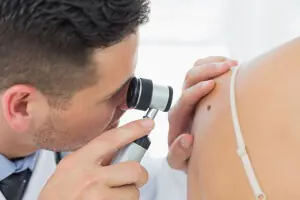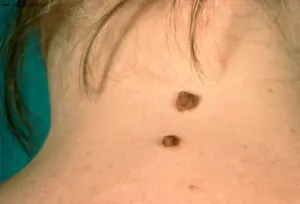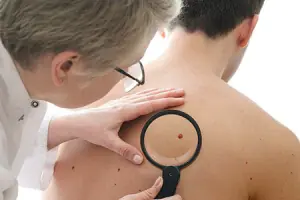Moles are congenital or acquired formations on the skin that are benign in nature. When a new mole appears, you can judge the increase in melanin in the skin cells.
Causes and time of appearance of moles

Moles on the human body
Moles appear at the age of more than ten years. The location of moles can be any part of the human body. The number of moles on the body directly depends on the individual characteristics of a person. Moles or nevi may not be visible only on the body of a newborn baby. During puberty, adolescents experience an increased amount of hormones, which leads to the appearance of moles.
A mole is a congenital malformation of the skin. It must be handled as carefully as possible.
If a neoplasm appears that causes anxiety in a person, he can seek help from a dermatologist.
If there are changes in the tumor, it is necessary to consult an oncologist. If your mole is located in an open place, which leads to injury, then you need to seek help from an oncologist. A mole is a benign neoplasm, which in itself cannot cause harm to human health.
Damage to a mole

It often happens that a person accidentally damages a mole. This is explained by their inconvenient location, which causes nevi to succumb to mechanical stress or accidental tearing off.
Places that are undesirable for moles include:
- Face
- Soles of feet
- Waist
- Groin
- Armpits
- Collar area
When a mole is located in these places, it is constantly exposed to the possibility of damage, which can have negative consequences. If damage to the nevus in these places occurs regularly, then it would be best to remove it.
If a mole is damaged, a person will immediately feel a sharp pain that has a burning character.
If the skin is damaged when exposed to a mole, the patient will bleed. The appearance of nevi occurs in different layers of human skin, which is reflected in their appearance. Moles can be either flat or convex. When a mole is damaged, some patients complain of burning and redness. If a mole is torn off, the patient will experience necrosis of its skin. If a person simply scratches a mole, and it is characterized by the absence of blood, then he may experience ordinary discomfort.
Damage to a mole is characterized by the presence of pronounced symptoms, which makes it possible to determine the degree of damage. After this, the person chooses methods of treating this damage.
First aid for a ruptured mole

Treatment of a mole tear
The most common is incomplete damage to a mole. This appears as a result of a tear or snag on a mole. Partial damage to a mole is the condition in which it remains on the body. Providing first aid directly depends on whether the wound bleeds when a nevus is damaged or not.
If there is blood after damage to a mole, first of all, it is necessary to disinfect the wound and stop the bleeding.
This action can be performed using a clean bandage and an antiseptic in the form of hydrogen peroxide or an aqueous-alcohol solution of chlorhexidine:
- Initially, the injured mole is washed with peroxide. At the same time, you should not regret this medication.
- The bandage must be soaked generously with peroxide so that liquid drips from it.
- The resulting tampon must be applied to the nevus and held until the bleeding stops.
- When using hydrogen peroxide, you can simultaneously disinfect the wound.
The next step in treating the wound is washing it. For this purpose, chlorhexidine is most often used. This is a highly effective antiseptic, which is characterized by the presence of a disinfecting effect that lasts for quite a long time on the mole. After the bleeding has stopped, it is necessary to wet the wound with a bandage containing chlorhexidine, which will allow it to be disinfected as efficiently as possible.
In the absence of Chlorhexidine, Iodine can be used to lubricate the edges of the wound.
After treating the mole, a sterile bandage is placed on top of it. For this purpose, a bandage is used, which is fixed with a sterile plaster. If the damage to the mole does not go away within 24 hours, then it would be best to seek help from a doctor. Only a specialist can decide whether to remove or preserve the nevus, depending on the extent of its damage.
Video about what is necessary when a mole breaks and falls off. .
A mole can be damaged in different ways - completely torn off or torn. The main thing is not to get confused and know how to provide first aid in order to prevent serious consequences and not cause complications.
">



